


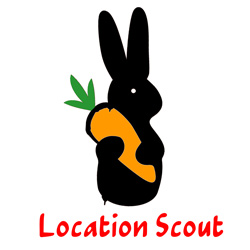


 |
| All my books take place in real locations. I like the idea that even in something as odd as The Eyre Affair, you can still, with a little bit of guesswork, figure out which house is Thursday's Mum's - and even follow the route Miss Havisham takes when she drives the 27-litre Higham Special racing car out of Shrivenham on the A420 and towards Swindon. But since this is fiction, I do have a fair degree of licence and I generally enhance and alter said locations as the narrative demands. Y'know the sort of thing: Add a monorail or reopen an old branch line. It's kind of arbitary, too. Some remain unchanged, like the Old Town in Thursday Next's Swindon, but others are altered radically, like East Carmine from Shades of Grey , which really only share the topography and road layout. Early Riser was a mixture of both - I took what was there and then wove it into the story. The Constant Rabbit takes place mostly in Herefordshire with a small section across the border in Powys. All the locations are well known to me or were scouted especially for the book; I did something similar for Early Riser and The Nursery Crime Series. Unfortunately, due to the constraints of the lockdown, the photographs accompanying the text are a mixed bag of ones I took a while ago specifically as content, others that I just happen to have in my archive, and a few from fab.creator with my thanks. So: let's have a look and see where the book takes us. It might help to read my What's it all about? page first for a sense of orientation. Okay, let's go. Location one: Ross On Wye. |
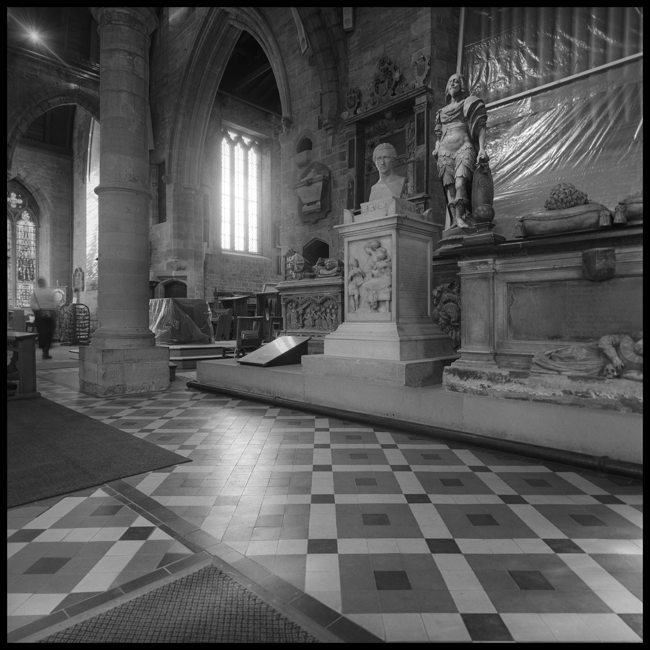 St Mary's Parish Church, the interior. Ross on Wye is a rabbit town, an early experiment at integration that despite being a dazzling success, was not rolled out further. Today, Ross has a vibrant rabbit life: "The gourmet lettuce bars did particularly well, as did the numerous greengrocers, a thriving bookstore and several Hookahdens where rabbits discussed politics, economics and carrot hybridisation issues while their hookahs bubbled and puffed with the aromatic scent of a variety of rabbittobacco: dock-leaf, catnip, burdock, celeriac and dandelion." Peter Knox is reluctantly on Ops, pursuing a 'rabbit of interest' into St Mary's church where, after making comment on the fine tombs, he speaks to the clergy on the theological issues surrounding anthropomorphised rabbits: "I think the problem is that while humanlike, they are not actually humanful, and according to scripture and teaching, mankind was made in His image, as their Grand Matriarch Lago was made in theirs. Church policy these days is that we don't allow them to participate in church matters but we will not exclude them from our house - so long there is no crunching of lettuces from the pews and pellets are kept to an absolute minimum." The location is real; hopefully you'd be able to recognise it from the book. Location Two: May Hill, above Ross. |
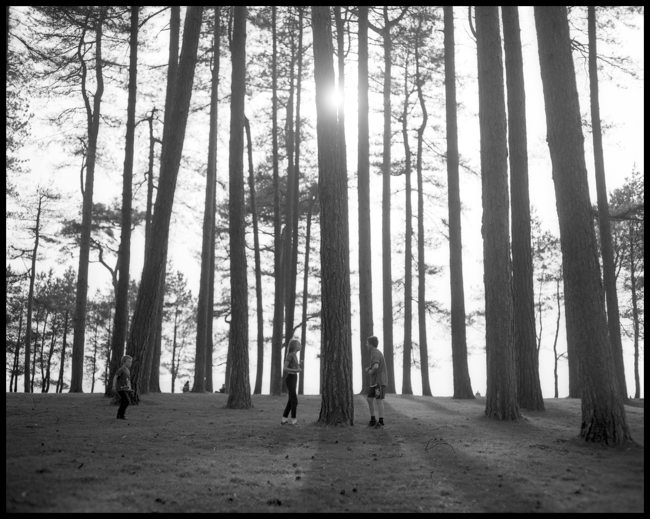 The 1.8 million Rabbits are kept - aside from those who are licensed to be 'off colony' - in one of five colonies: RabCol 1: Epping Forest RabCol 2: Ross RabCol 3: Bodmin RabCol 4: Cleethorpes RabCol 5: Blackpool The Colony above Ross is at May Hill, an easily recognisable landmark from many miles away - on a clear day I can see it from my Mum's house, 42 miles distant. There is a distinctive knot of trees and the hill itself a favourite place for walkers. I went up there last year to get the feel of it as quite important things happen there in the book. My May Hill is very different - with call centres, manufacturing facilities, a huge amount of market gardening, a Lago Meeting House and about three hundred miles of warrens - no-one knows the precise number. Whilst I was there on the scout, kids were playing tag around a tree. Location Three: All Saints, Hereford. |
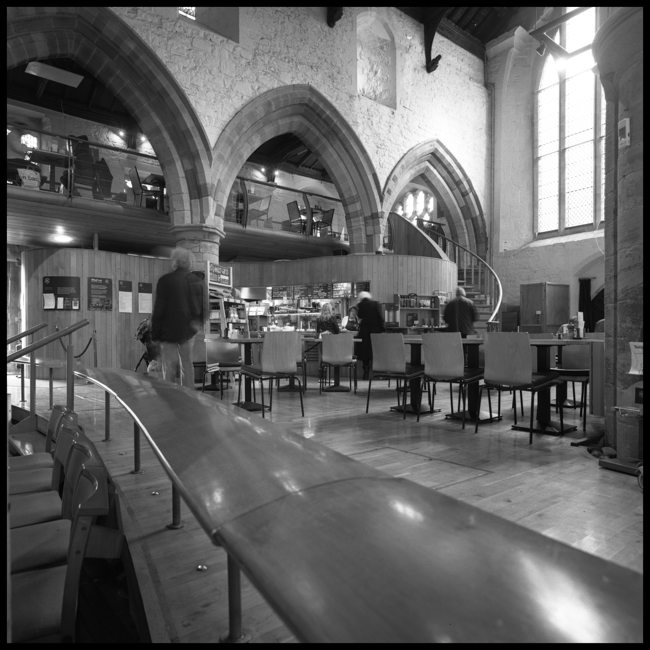 All Saints Church is also a cafe, and usually where Peter goes for lunch. The waitresses are rabbits in the book, and there are a few altercations in the cafe, where the reactions of the other cafe-goers tell us much about how rabbits are viewed. It's a very good cafe, by the way - recommended. Location Four: The RABCoT building, Hereford. |
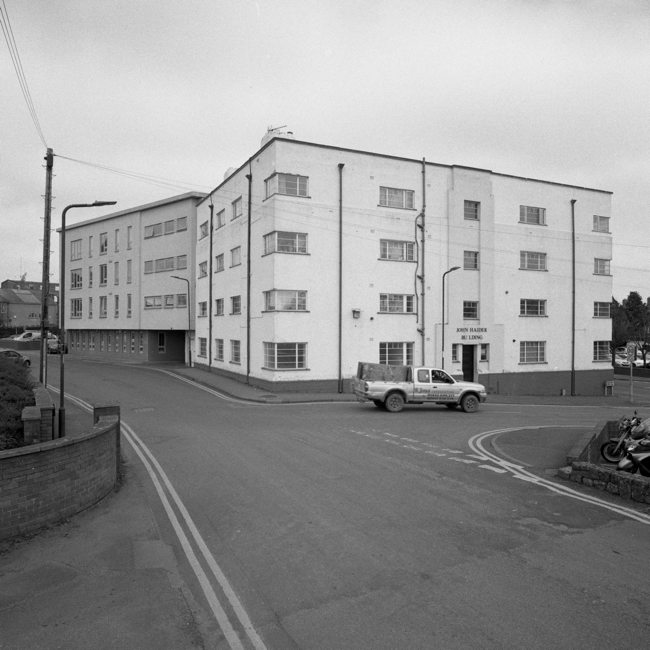 Although Colony One is located just above Ross, the regional headquarters of the Rabbit Compliance Taskforce (RabCoT for short) is in Hereford, from where it administers the many rules and regulations that govern rabbits, and from where Colony One is remotely run. Nigel Smethwick named this centre after himself when he became the Minister for Rabbit Affairs, a job he pursued with all gusto and eventually led to his job as the Prime Minister. His party now, as always, was UKARP: The United Kingdom Anti Rabbit Party. The building I chose is actually a residential block called the John Haider Building. It's on Gas street, just local to the police station and magistrate's court. The road to the left of the picture was where the rabbits staged their protest: "..To be honest, it was only dubbed a 'riot' later, by the leader writer of The Actual Truth, UKARP and the Compliance Taskforce. To anyone else, the rabbits themselves and even a dispassionate observer, 'super nonviolent silent protest with maths' would be closer to the mark..." Location Five: Rhayder, Wales, site of Megawarren |
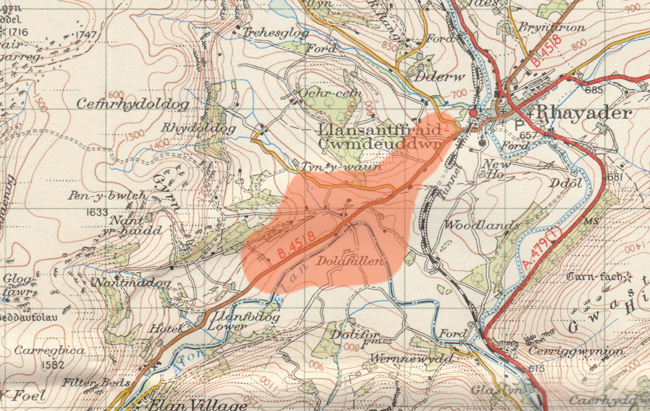 This is an old 1952 map which still shows the railway and a relatively small Rhayder - it's crept Eastwards since then. The area in red is roughly the site for the Government's much vaunted solution to the ongoing rabbit issue once and for all: "The site, after protracted and delicate negotiations with the Welsh Assembly, was just South of the Elan Valley and sandwiched between the reservoir complex and Rhayder itself, an ideal location as the railway from Builth had been relaid to allow ease of transportation for the million or so rabbits who would live there. At close to ten thousand acres and with a seventeen mile perimeter fence - or wall, if they could get the rabbits to pay for it - MegaWarren would be large enough, Smethwick, said: 'to find a lasting, workable and cost-effective solution to the pressing rabbit issue once and for all, but not so large as to encourage irresponsible levels of reproduction." Location Six: Much Hemlock, Hemlock Towers location |
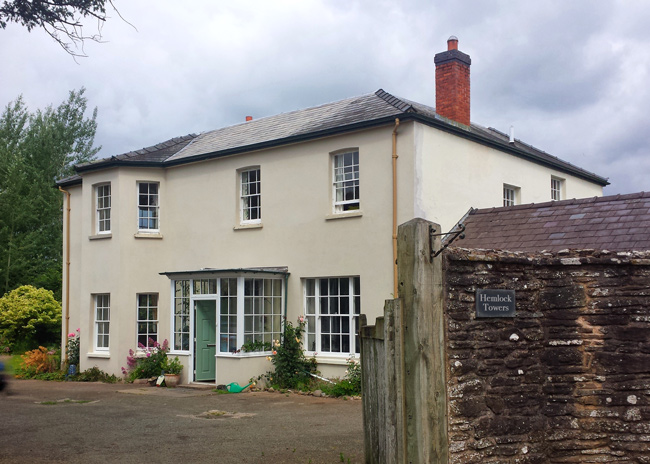 Several villages portray Much Hemlock in the book and Herefordshire does have its fair share of pretty villages. The name 'Much Hemlock' sort of dropped into my lap as it does sound vaguely Herefordish. 'Much Wenlock' is a village in Shropshire (North of Herefordshire) and incidentally where the modern Olympics started, but many villages in Herefordshire have names which seem to defy easy etymological understanding. 'Yazor' is a good one, along with 'Foy','Canon Pyon', 'How Caple', Much Marcle', 'Stoke Lacey' and so on. There is actually a 'Much Birch' but this probably refers to the tree, not the punishment. The book didn't have to be set in Hereford, of course, but it is local to me, and it is kind of middle England. This is the location of the house that I decided would be Hemlock Towers - it is next to a church as in the book, and has the old stable block opposite, again, like Peter and Pippa's house in the book. Picture credit: fab.creator (Instagram) Location Seven: Much Hemlock, Hemlock Towers facade. |
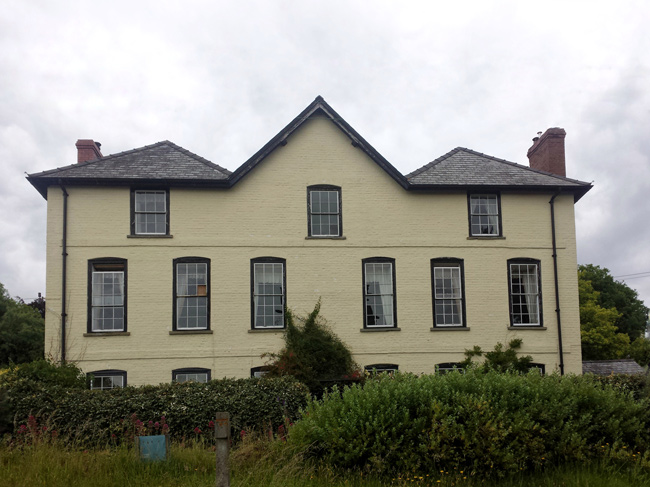 The look of Hemlock Towers is more like this: An imposing facade, about ten miles away in a place called Almley. This house is opposite the church, which is a fairly bland Victorian edifice - but with what looks like much more ancient painted barrel vaulting above the nave. There's a small castle mound beyond the churchyard, too - and one of those original round yellow AA signs that tell you what village you are in, and how far to everywhere else. Picture credit: fab.creator (Instagram) Location Eight: Much Hemlock, Peter and Pippa's house. |
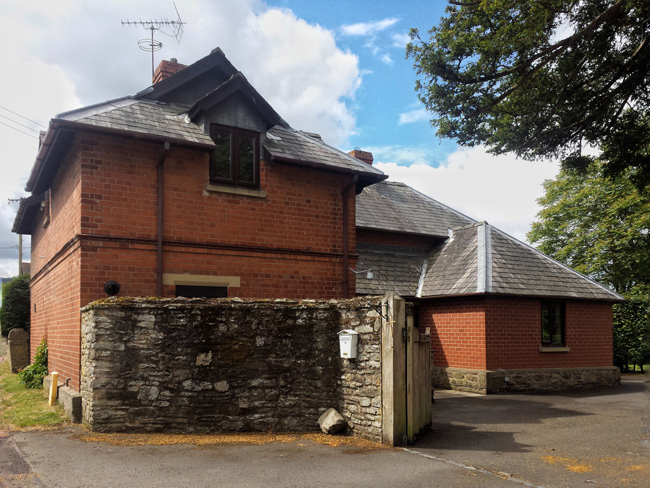 Location only, really. I've no idea of the layout - just that the houses face one another. I made the fence between Peter and the Rabbit's house a hedge, too - so they could look over it. Mr Wainwright's house is behind this, but I don't have a picture of it. Picture credit: fab.creator (Instagram) Location Nine: Much Hemlock, The Unicorn Pub |
 This pub is for real, and one of the very fine purveyors of food in Weobley, where it can be found. Weobley has been used a couple of times before, in giveaway postcards. If anyone recalls the 'painting the telephone box' postcard for Shades of Grey , that notoriously unsequelled book, it's opposite here on the walk up to the castle. In my book, this is the cosy watering hole of the notoriously intolerant Mallet Brothers - a long resident family in the area, who have taken their standing within the community and used it to assume the power of arbitration as to how they think the village should be. The Mallet brothers are, unusually, one group of antagonists in my books they are left purposefully without any redeeming features; they are simply hateful. The chief antagonist in TCR is the Senior Group Leader of the Regional Rabbit Compliance Taskforce, who while certainly of far greater evil and power than the Malletts, does have a certain dark charm. Picture credit: fab.creator (Instagram) Location Ten: Merino Ram statue, Goulburn, Australia |
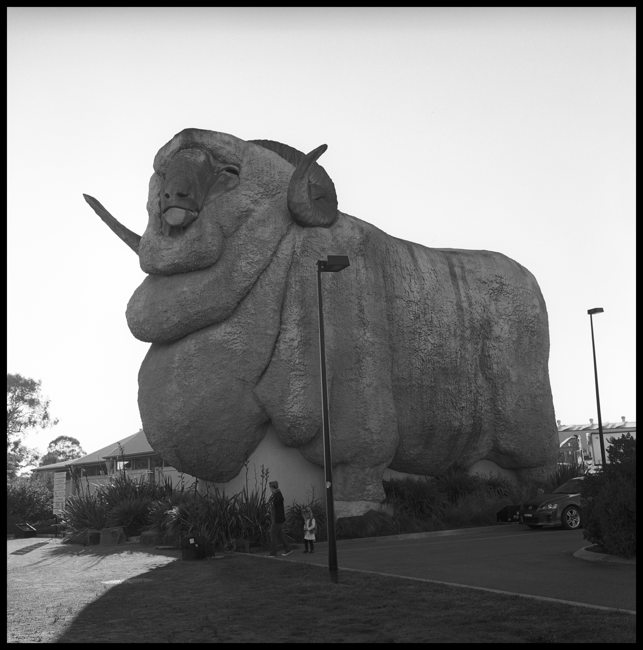 Can't tell you much about this due to spoilers, but Rambo and Goulburn are referenced in the book, even if the action does not take us there. This impressive statue - there should totally be one on the A438 as it goes into Powys from England - is by the side of the road as you drive into Goulburn having left the Hume Highway from the Canberra direction. Location Eleven: Cadillac Eldorado belonging to Lugless. |
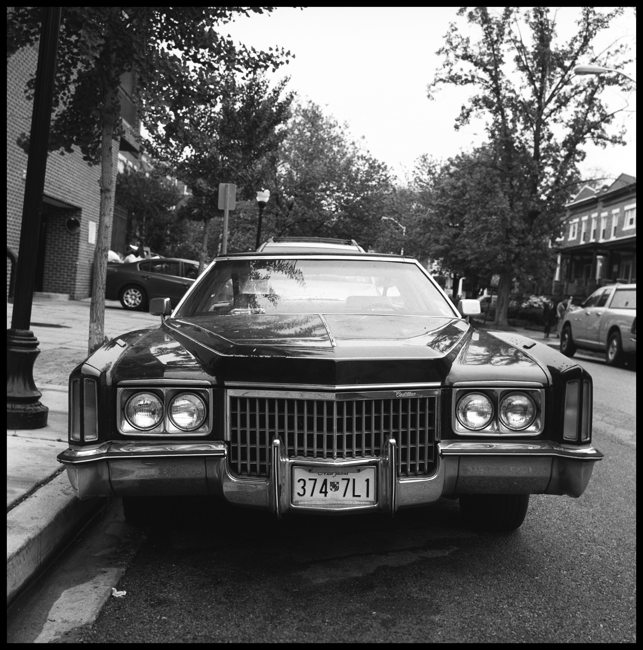 Although anthropomorphised, rabbits have their own unique way of doing things, code of conduct and approach to life: "..Rabbits liked large American cars as they were better suited to their physique and limited levels of dexterity. Bench seats, auto transmission, feather light power steering and large pedals. They also took great care of the cars as rabbits viewed obsolescence as the arrogant cousin of waste and thus incompatible with the 4th circle of their faith: Sustainability. There was a rabbit saying: 'Nfifnfinnfiifnnfifnfn' which roughly translates as: 'Only a fool buys twice'..." Their love of technical longevity also extends to the home: "..Because of their dislike for obsolescence, rabbits only chose domestic appliances that would last a minimum half a century. Dualit toasters were favoured, as were Hoovermatic washing machines, vintage Kenwood Chef food mixers, 70's push-button phones, treadle sewing machines and large format cameras. They loved wet-chemistry photography, the older the process the better..."" I spotted this Eldorado in Baltimore on a street corner. I think it's a 1976 model, the two door coupe with the 'Opera Windows' and is by far and away (to me) the most charming of the range - it just sings 'seventies' in a way that's hard to express in words. Mr and Mrs Rabbit own and drive a 1974 Dodge Monaco, the same one that Jake and Elwood drive. Later on when we meet Harvey he is driving a Chevy Impala Taxi, dated from about 1959 with the 'horizontal teardrop' rear light cluster. The final USA car I reference is driven by a 'flea bitten old buck' and is described as a 'charmingly ugly 1973 Ford Gran Torino'. Okay, I think that's it for now. As usual, the owners of these locations - whoever they are - are obviously unrelated to the story in any way. I just used the locations to figure out the geography in my mind. |
|
|
|
Updated June 15th 2020 |